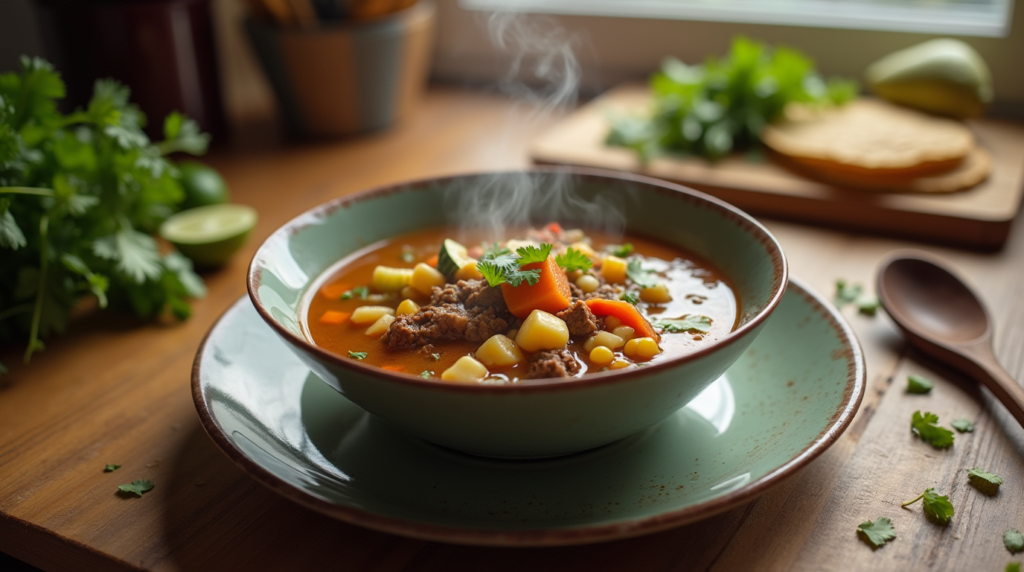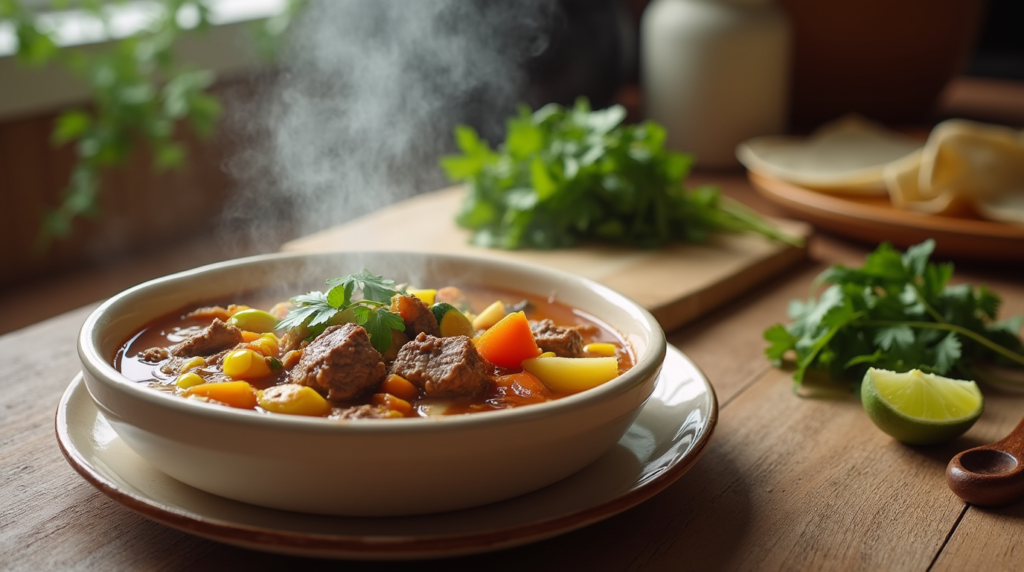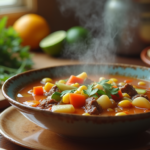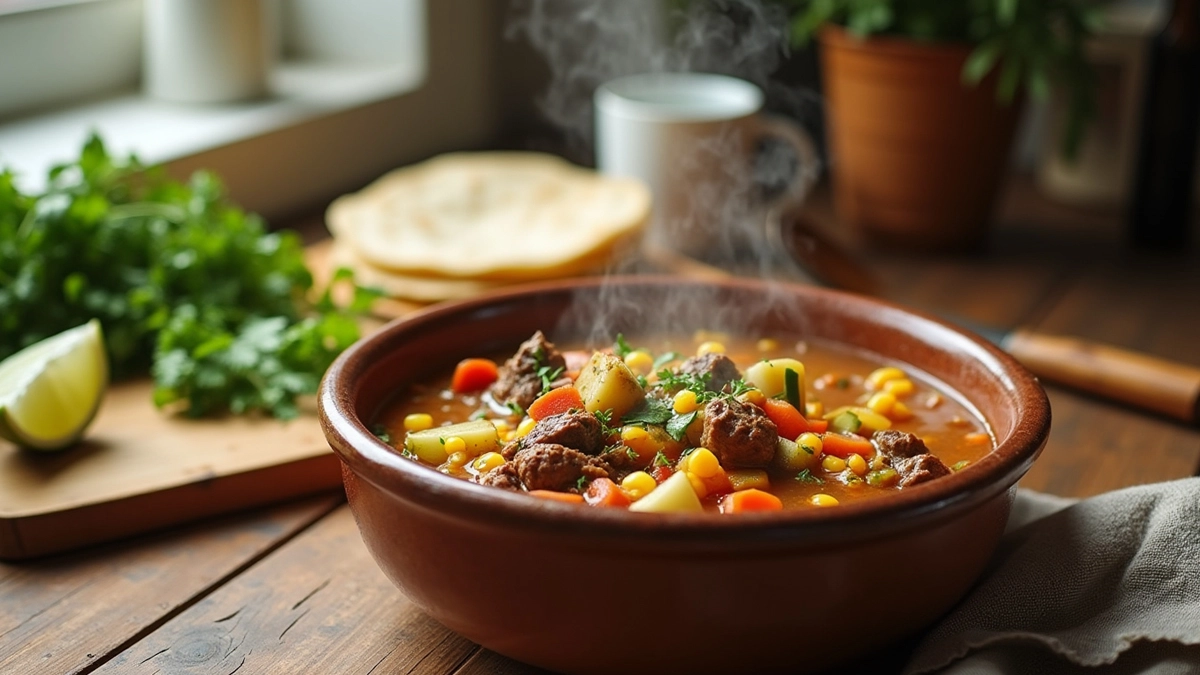Caldo de Res is a traditional Mexican beef soup that has captured the hearts of many with its rich, flavorful broth and tender beef. This hearty dish is a favorite comfort food, often served on special occasions or as a nourishing family meal. If you’re looking to recreate this classic Mexican soup at home, our caldo de res recipe will guide you through the essential ingredients and cooking techniques to achieve an authentic, delicious dish. In this article, we’ll not only provide a step-by-step recipe but also share regional variations, helpful tips, and answers to frequently asked questions about caldo de res.
What is Caldo de Res?
Caldo de Res is more than just a soup—it’s a flavorful and nourishing dish that brings together tender beef, hearty vegetables, and a rich, savory broth. The dish originates from Mexico and is commonly enjoyed in homes across the country. It is typically made by simmering beef shank, short ribs, or oxtail in water for hours, allowing the beef’s natural flavors to infuse the broth. The vegetables—potatoes, carrots, corn, zucchini, and sometimes cabbage—add not only color but also a variety of flavors and textures that make the soup an incredibly satisfying meal.
The beauty of caldo de res is that it’s both simple and versatile. It can be enjoyed as a standalone dish or paired with sides like tortillas, Mexican rice, or beans to create a more substantial meal. If you’re looking for a comforting, flavorful soup to warm your soul, caldo de res is the perfect dish to try.
In case you want to explore other hearty Mexican beef recipes, this guide to making the Ultimate Beef Chuck Roast will give you some inspiration.

Key Ingredients for Caldo de Res
To create an authentic caldo de res, you’ll need the following key ingredients. Each element plays an important role in building the rich, hearty flavor that makes this dish so beloved.
1. Beef Shank or Short Ribs
- Beef shank: This is the most traditional cut for caldo de res. The shank is rich in marrow, which contributes to the deep, savory broth. When cooked, the beef becomes tender and flavorful.
- Beef short ribs: Another excellent option, especially if you’re looking for a bit of extra fat and flavor. The bones help enrich the broth and add a satisfying texture.
2. Vegetables
- Corn: A defining feature of caldo de res, corn on the cob adds a subtle sweetness and rustic flavor to the broth. Make sure to use fresh or frozen corn for the best results.
- Carrots: Carrots add both sweetness and color, which complement the savory broth.
- Potatoes: Soft, starchy potatoes are often used to help thicken the broth and add body to the soup.
- Zucchini: While not as traditional, zucchini is often added in modern recipes for extra flavor and texture.
- Cabbage: A handful of cabbage brings freshness and a slight bitterness that balances out the richness of the beef.
3. Aromatics
- Onion: Adds a depth of flavor that forms the base of the soup.
- Garlic: Essential for building flavor, garlic pairs wonderfully with the beef and vegetables.
- Cilantro: A handful of fresh cilantro is added toward the end of cooking for a burst of freshness.
- Lime: A squeeze of lime just before serving helps brighten up the dish.
4. Seasoning
- Salt and pepper: These are essential for seasoning the broth. You can also add chili powder or other spices if you like your soup on the spicier side.
- Optional additions: Some variations of caldo de res might include additional seasonings like bay leaves, oregano, or even a splash of salsa verde for added depth.

The Broth: The Heart of the Dish
The key to an exceptional caldo de res is the broth. It should be rich, savory, and full of flavor, and the best way to achieve this is through slow cooking. Let’s take a closer look at how to make the broth the star of your dish.
1. Choosing the Right Beef Cuts
Start by selecting the best cuts of beef for the broth. Beef shank and short ribs are ideal because they contain a good amount of bone and connective tissue. The marrow in the bones releases rich flavor into the broth as it cooks. If you prefer a more gelatinous texture, consider using oxtail, which also adds a deep, savory flavor to the broth.
2. Slow Cooking for Depth of Flavor
The longer you cook the meat, the more flavor will develop. Begin by adding your beef cuts to a large pot and cover with cold water. Bring the mixture to a boil, then reduce the heat to a simmer. This slow-cooking process allows the collagen in the beef to break down, creating a silky, flavorful broth.
While the broth simmers, make sure to skim off any scum that rises to the top to ensure a clear soup.
3. Adding Vegetables and Aromatics
Once the beef is tender (about 2-3 hours of simmering), it’s time to add your vegetables. Start by adding the potatoes, carrots, and corn to the pot, followed by the zucchini and cabbage. Let everything simmer for another 20-30 minutes until the vegetables are soft.
As the vegetables cook, you can also add your aromatics—onion, garlic, cilantro, and a bit of lime juice. The aromatics help enhance the broth and balance the flavors.
Step-by-Step Recipe: Making Caldo de Res
Now that you understand the key components of the dish, let’s go step by step through the process of making caldo de res. Whether you’re a beginner or an experienced cook, this recipe will guide you through each stage of creating this delicious and hearty soup.
1. Preparing the Meat
Before you start cooking, it’s important to properly prepare the beef. The beef shank and short ribs should be cut into large chunks, ensuring they fit comfortably into your pot. If you’re using beef with bones, this will allow the marrow to be released into the broth.
Tip: If you want a clearer broth, consider blanching the beef first by placing it in boiling water for about 5 minutes. This step removes impurities and helps create a cleaner-tasting soup.
2. Cooking the Soup
- Boil the beef: Place the beef in a large pot and cover with cold water. Bring to a boil over medium-high heat, then reduce the heat and simmer for 2-3 hours. Skim off the scum that rises to the surface to ensure a clear broth.
- Add vegetables: Once the beef is tender, add the chopped vegetables—carrots, potatoes, zucchini, and corn. Allow them to cook for about 30 minutes, until the vegetables are soft.
- Season the broth: Taste the broth and add salt, pepper, and any additional seasonings to your liking. You can add a touch of chili powder or a pinch of oregano for extra depth.
3. Final Touches
Add a handful of fresh cilantro to the pot just before serving to enhance the freshness of the soup. Squeeze fresh lime juice over the soup for a tangy kick, and adjust the seasoning to taste.
Variations of Caldo de Res
While the traditional caldo de res recipe is simple, there are many regional variations that incorporate different ingredients and techniques. These regional differences add unique flavors to the dish and are a great way to explore the diversity of Mexican cuisine.
Oaxaca
In the state of Oaxaca, caldo de res might be prepared with chile pasilla, a smoky dried chili that adds a depth of flavor and a bit of heat to the broth. This variation is perfect for those who enjoy spicy and smoky flavors.
Veracruz
In Veracruz, caldo de res might include chayote (a type of squash) and plantains for a sweeter twist. These ingredients add a contrasting flavor and texture to the broth.
Northern Mexico
In northern Mexico, caldo de res might be served with a side of frijoles charros (charro beans) or bacon for added richness. The use of fresh herbs like cilantro and mint is also common in this region.
Serving Suggestions and Pairings
While caldo de res is delicious on its own, it pairs wonderfully with several traditional Mexican sides. Here are some options:
- Tortillas: Freshly made corn tortillas are perfect for dipping into the broth and soaking up the rich flavors of the soup.
- Mexican Rice: Serve caldo de res with a side of fluffy Mexican rice, which complements the soup and provides a satisfying texture.
- Refried Beans: For an added protein boost, serve the soup with a side of refried beans or frijoles negros (black beans).
- Salsa: Add a little heat and tang by serving caldo de res with a side of spicy salsa verde or salsa roja.
If you’re interested in other beef-centric recipes, this hearty beef stew is also a great dish to try.
Conclusion
Making an authentic caldo de res is a satisfying and rewarding experience. The combination of tender beef, fresh vegetables, and rich broth creates a meal that’s both comforting and nourishing. Whether you’re cooking for family or friends, caldo de res is the perfect dish to bring people together and celebrate the flavors of Mexico.
By following the steps outlined in this recipe, you can create a flavorful and hearty meal that’s perfect for any occasion. Don’t be afraid to experiment with regional variations and adjust the seasoning to your taste. Enjoy your caldo de res with tortillas, rice, or beans for the ultimate Mexican comfort food experience!
Print
The Ultimate Caldo de Res Recipe: A Hearty Mexican Beef Soup
- Total Time: 2 hour 15 minutes
- Yield: 8 servings 1x
- Diet: Gluten Free
Description
Learn how to make an authentic caldo de res recipe with tender beef, fresh vegetables, and a rich, savory broth. This traditional Mexican beef soup is perfect for any occasion, offering comfort and flavor in every bowl.
Ingredients
For the Soup Base:
- 2–3 lbs beef shank (or short ribs, oxtail, or a combination of these cuts)
- 8 cups water (or beef broth for extra richness)
- 1 medium onion, quartered
- 4 garlic cloves, smashed
- 1–2 bay leaves
- Salt and pepper, to taste
Vegetables:
- 3 large carrots, peeled and cut into chunks
- 3 medium potatoes, peeled and cut into chunks
- 2 ears of corn, cut into 3-4 pieces each (fresh or frozen)
- 2 medium zucchinis, sliced into rounds or half-moons
- 2 cups cabbage, chopped (optional but adds great texture)
Garnishes and Flavor Enhancers:
- 1 bunch cilantro, chopped (for garnish)
- 2–3 limes, cut into wedges (for serving)
- Chili powder, or fresh chilies, to taste (optional for heat)
- Hot sauce (optional, for extra spice)
Instructions
1. Prepare the Meat
- Begin by trimming any excess fat from the beef shank, short ribs, or oxtail, depending on what you’re using.
- Cut the beef into large chunks to ensure they fit comfortably in your pot. If you’re using beef with bones, make sure the pieces are large enough to allow the marrow to release into the broth.
Tip: If you prefer a clearer broth, blanch the beef before cooking. To do this, place the beef in a pot of boiling water for 5 minutes, then drain and rinse the beef. This removes impurities and helps create a cleaner, more flavorful broth.
2. Cook the Broth
- In a large pot, add the beef, bay leaves, onion, garlic, and water (or beef broth for more flavor). Bring to a boil over medium-high heat.
- Once boiling, reduce the heat to low to allow the soup to simmer slowly. Let it simmer for 2-3 hours, occasionally skimming off any foam or impurities that rise to the top to keep the broth clear.
Tip: Skim regularly to ensure the broth remains clean and free of scum.
3. Add the Vegetables
- After the beef has become tender (about 2-3 hours), it’s time to add the vegetables. Start with the harder vegetables: carrots, potatoes, and corn. Add them to the pot and let them cook for about 20-30 minutes, or until they begin to soften.
- Then, add the zucchini and cabbage (if using). Continue to simmer for an additional 10-15 minutes, until the vegetables are fully cooked.
4. Season the Broth
- Taste the broth and season with salt and pepper to your liking. You can also add a pinch of chili powder or a few slices of fresh chili if you prefer a spicier soup.
Optional: For an added depth of flavor, sprinkle in a pinch of oregano or a few slices of jalapeño.
5. Final Touches
- Once the soup is ready, remove the beef from the pot and shred it into bite-sized pieces. Return the shredded beef to the pot.
- Add a handful of fresh chopped cilantro to the soup just before serving for a burst of freshness.
- Squeeze in some fresh lime juice just before serving to brighten up the flavors.
6. Serve and Enjoy
- Ladle the caldo de res into bowls, ensuring each serving has a good mix of beef and vegetables.
- Serve the soup with warm corn tortillas on the side for dipping, or pair it with a serving of Mexican rice and refried beans for a more substantial meal.
- You can also offer salsa on the side for those who enjoy a bit of extra heat.
Notes
1. Beef Cut Selection
- While beef shank is the most traditional cut used for caldo de res, you can also use short ribs or oxtail for a richer broth due to the higher fat content and marrow in the bones. If you’re looking for a leaner version, round or chuck roast can also be used, though it won’t have the same depth of flavor from the bone marrow.
2. Cooking Time
- The longer you simmer the beef, the more tender and flavorful the broth will become. If you have time, aim for at least 2-3 hours of simmering. If you’re in a rush, you can use a pressure cooker or Instant Pot to cut down the cooking time to about 45-60 minutes.
3. Vegetable Variations
- Caldo de res is a flexible recipe, and you can add or substitute various vegetables depending on what’s in season or your preferences:
- Sweet potatoes can be added for a touch of sweetness.
- Celery or chayote (a type of squash) are excellent additions if you want more flavor complexity.
- Mexican squash (like calabacitas) is often used in traditional variations and can be swapped with zucchini.
4. Clear Broth Tip
- If you prefer a clearer broth, you can strain the soup after the initial simmer. This will remove any floating bits of meat, onion, or garlic, giving you a cleaner, more refined broth. However, some people enjoy the rustic look of a more hearty, full-bodied broth with bits of onion and garlic still in it.
5. Serving Suggestions
- Caldo de res is often served with a side of warm tortillas or Mexican rice. You can also offer sour cream, cheese, or a variety of fresh salsas to complement the dish.
- For an extra touch, serve the soup with avocado slices or a sprinkle of crumbled queso fresco on top.
6. Leftovers and Storage
- Caldo de res is one of those dishes that tastes even better the next day! The flavors continue to develop and deepen, making it an ideal make-ahead meal.
- Store leftovers in an airtight container in the fridge for up to 3 days.
- To reheat, simmer the soup gently on the stovetop to bring the flavors back to life.
- You can freeze caldo de res for up to 3 months, though the vegetables may lose some of their texture when reheated.
7. Spicy Variation
- If you like your soup with a bit of heat, you can add fresh jalapeños, serrano peppers, or chipotle to the broth during the simmering process. You can also serve with a side of salsa roja or salsa verde to control the spice level as desired.
8. Regional Variations
- Depending on the region of Mexico, caldo de res can vary slightly in its ingredients. For example, in the north, you may find the addition of dried chiles for a smoky, earthy flavor, while in coastal areas, tomatillos might be used to give the soup a tangier taste. Feel free to experiment with regional twists that reflect your personal tastes.
- Prep Time: 15 minutes
- Cook Time: 2 Hours
- Category: Mexican Soups
- Cuisine: Mexican
Nutrition
- Serving Size: 6 Servings
- Calories: 300-350 kcal
- Sugar: 5g
- Sodium: 600-800mg
- Fat: 15-20g
- Saturated Fat: 5-7g
- Carbohydrates: 20-25g
- Fiber: 3-4g
- Protein: 30-35g
- Cholesterol: 70-90mg
Keywords: caldo de res recipe, Mexican beef soup, traditional beef soup, Mexican beef stew, hearty beef soup, caldo de res, Mexican comfort food, Mexican soup recipe, beef shank soup, caldo de res ingredients, Mexican broth-based soup

